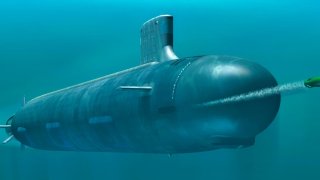The U.S. Navy Has One Problem with the Virginia-Class Submarine
Churning out Block V U.S. Navy Virginia-class submarines is just as important as getting Columbia-class ships out on the water as soon as possible. However, workforce shortages may rule out the timely introduction of both platforms.
The U.S. Navy can’t build Virginia-class submarines fast enough: While it was already obvious that the U.S. Navy’s newest submarines were failing to meet their original production timelines, recent reports suggest that Virginia-class ships could face years-long delays.
According to reports in January, a workforce shortage at Fincantieri’s Marinette Marine shipyard is slowing production of a first-of-class guided-missile frigate. When concerned Navy officials carried out an extensive review of the service’s shipbuilding portfolio, they discovered that many of the Navy’s premiere shipbuilding programs were running at least a full year behind schedule.
According to Defense News, construction of Block IV Virginia-class submarines was running about three years behind schedule. Tensions between Washington and Beijing increase the urgency for accepting these submarines into service.
Introducing the Virginia-Class
When the Soviet Union collapsed and the Cold War faded in the early 1990s, the Navy first looked to its Seawolf-class submarines to replace the aging Los Angeles class. However, these ships were canceled due to budgetary constraints after only three were produced. The Virginia class gave the Navy a cost-efficient alternative to the Seawolf ships – the Virginia subs cost roughly $1 billion dollars less. The first Virginia-class SSNs entered service in the early 2000s able to operate mission sets including anti-submarine warfare, intelligence gathering, reconnaissance, and littoral operations.
Manufacturers Newport News Shipbuilding and General Dynamics Electric Boat designed a small version of a Virginia-class submarine in 2001 that would become an affordable test platform for trying out newer technologies. These two manufacturers have built all 21 Virginia-class submarines in service today, as they are the only shipyards of their kind able to build nuclear-powered SSNs.
Specs & Capabilities:
Earlier Virginia-class variants measured 377 feet long and 34 feet wide, with displacements of 7,800 tons when submerged. Later SSN blocks entered service over the years, and most of the 21 Virginia ships in service today are Blocks I through III. Only three Block IV vessels are deployed today, with several more under construction. Block III SSNs are equipped with 12 vertical launch tubes for Tomahawk land attack missiles, and other modifications that help enhance flexibility. The Virginia Payload Tubes fitted on these ships reduce acquisition costs and increase payload flexibility.
Although every Virginia-class SSN is powerful, the latest Block V variant is especially so. These models’ lengthened hulls can fit the Virginia Payload Module (VPM), which carries additional cruise missile tubes. The payload increase alone sets the latest Virginia variant apart from its sister ships. As detailed by The Drive, the VPM will feature a hull plug that can be adapted to the seabed warfare role “instead of hauling around cruise, hypersonic and other missiles.” Additionally, the submarine is able to incorporate new technologies as they emerge, a cost-saving function.
While the Block V capabilities are unmatched, the production pace for these SSNs has slowed down. These submarines are being constructed by the same manufacturers responsible for building the latest Columbia-class vessels. Clearly, this workload may be too ambitious, as the schedules for both platforms keep getting extended.
As explained in a recent report by the Government Accountability Office, “While the fixed price incentive contract set target and ceiling prices for each submarine, program officials reported that the VCS shipbuilders have not met the work efficiency and material cost estimates that informed the target pricing. Consequently, the Navy plans to request more funds to complete Block V, as its prior budget requests covered the target prices, but not up to the ceiling prices.”
Churning out Block V Virginia variants is just as important as getting Columbia-class ships out on the water as soon as possible. However, workforce shortages may rule out the timely introduction of both platforms.
About the Author: Maya Carlin
Maya Carlin, National Security Writer with The National Interest, is an analyst with the Center for Security Policy and a former Anna Sobol Levy Fellow at IDC Herzliya in Israel. She has by-lines in many publications, including The National Interest, Jerusalem Post, and Times of Israel. You can follow her on Twitter: @MayaCarlin.


